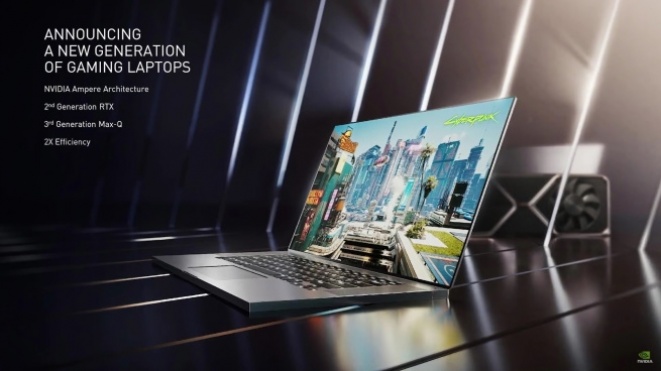GeForce RTX 30 Ampere - the gaming you've always wanted
Nvidia GeForce is the undisputed force that rules the gaming graphics card market. An opinion shared by many and with which the majority agrees. The release of the new GeForce card series has always been a big event in the PC industry that is eagerly awaited every time because we all know that in addition to performance improvements, Nvidia almost as a rule has an "ace up its sleeve" when it comes to additional features or graphics upgrades. . It is the same this time because the Ampere GPU brings a handful of novelties ...
Nvidia has introduced a new generation of AMPERE graphics processors and GeForce RTX 30 graphics cards based on them. It is the second generation of RTX architecture that brings faster Ray Tracing cores, a new organization of multiprocessor clusters, the third generation of Tensor cores for machine learning, all to significantly improve graphic details in games and higher execution speed to get perfect animation in games. A new era of PC gaming has begun!
Several important things happened for the first time. Thus, the GeForce RTX 30 models received 24 GB of local ultra-fast GDDR6X video memory. Increasing the number of executable processors requires a larger amount of memory as the amount of information regarding the quality and credibility of the screen display grows. These are the first gaming graphics cards that introduced the HDMI 2.1 standard necessary to play on 4K and 8K screens at high "fps" values. Also, these are the first models of graphics cards with hardware decompression of AV1 video format, which made it possible to watch video transmission in ultra-high resolution. Nvidia Ampere GPUs have become so powerful that they decompress high-quality, high-compression video formats in real-time, using significantly smaller files that are faster and easier to transfer over the Internet.
It is important to point out the fact that with the arrival of the GeForce RTX 3090 model it becomes possible to play in 8K resolution and display 60 frames per second. This fact speaks in favor of the claim that the title of the fastest gaming graphics card is in the hands of Nvidia. On the other hand, 4K gaming becomes practically "mainstream", enabling high values of the vertical refresh, which makes the animation in games perfectly smooth and fluid. Until yesterday, that was unthinkable on the previous generation of gaming graphics cards.
Nvidia has launched several GeForce models from the RTX 30 series: RTX 3070, RTX 3080, and RTX 3090. Soon, the RTX 3060 Ti will arrive. The most important fact per user is that the new generation represents the biggest generational leap in terms of performance and graphics effects in games.
Graphics processors based on the latest Ampere architecture, offer significantly better performance than the previous generation of Turing GPU-based models. In real life, this is reflected in far higher "framerate" values in high resolution, a much better feel in the game, but also setting new standards in terms of the quality of graphic details. Here we primarily mean advanced Ray Tracing light effects and the application of DLSS technology.
Another component of improving the quality of graphic details in games relates to the application of an advanced technique of rendering light effects - Ray Tracing, which is known for its high complexity in terms of hardware power. Simply put, Ray Tracing technology displays light effects like in real life: ray reflection, shadow objects ... it all looks photo-realistically vivid and is achieved by a combination of DLSS technology that helps the graphics processor deliver better performance without losing display quality pictures and animations. DLSS technology allows Ray Tracing effects to be experienced in real-time while playing. Together, these technologies have completely changed the look and feel of the game and have taken gaming to a significantly higher level overall.
These technologies work even better on the GeForce RTX 30 series, thanks to a more efficient Ampere architecture that is better suited to these computationally, very demanding operations.
To meet the high demands on computing power, the GeForce RTX 30 uses three types of processors: programmable executable units formerly known as CUDA cores then dedicated RayTracing processors that speed up the calculation of light rays, their crossing, surface bounce, and objects. The third type is Tensor processors that perform processing based on a machine intelligence algorithm.
Ray Tracing and raster rendering in terms of calculating detailed shadows, lights, material gradients, and similar jobs are very demanding. It would be very inefficient in terms of performance, to use exclusively CUDA processors for the entire list of these jobs. That's why part of the tasks are transferred to specialized processors that are designed to work simultaneously. This way of working raises the overall performance of the graphics card.
Each of the mentioned processors also existed in the previous version of the Turing architecture with which Nvidia exclusively introduced Ray Tracing rendering into gaming use. Until then, the only technology used in gaming was rasterization technology, significantly less demanding in terms of GPU processor power, but also less convincing in terms of photorealistic graphics details. Now it has become all different and more demanding. The story of gaming has taken on a new and more serious dimension as the stakes have risen significantly compared to past times.
Such a complex graphics processor structure with advanced executable cores whose efficiency has doubled compared to the previous generation of GeForce graphics cards is essential for Ray Tracing shading jobs. To go a step further in the application of even more effective lighting effects, the presence of all three most numerous types of processors is necessary, so it should come as no surprise that Ampere GPUs number over 20 billion transistors, which is a challenge for production.
It was necessary to make a breakthrough in terms of raw performance, so all three types of processors on the Ampere GPU generation received improvements. CUDA cores are now able to perform two calculations per clock compared to one for which the Turing generation was capable of. At the same time, RayTracing processors have become more powerful because in the second generation they can deliver twice as much data when executing the RT algorithm on the crossing and reflection of light rays in three-dimensional space. Finally, Tensor cores are now able to automatically identify less important tasks and thus duplicate the speed of the entire process network performed by the machine intelligence algorithm set up on the neural network system.
You can think of Tensor cores as the brains of GeForce graphics cards. Their role is to speed up the calculations of matrices and vectors used in the functioning of neural networks, which is the foundation of the existence of modern artificial intelligence. In the scope of the Tensor processor, one of the priorities is the Nvidia DLSS function. Tensor cores take advantage of the neural network to extract essential features of the rendered scene and intelligently combine them with multi-frame details, all to produce a high-quality final frame and thus free up the GPU processor of unnecessary work. This achieves significant progress in performance, ie an increase in "frame rate" in games. This functionality also makes it easy to achieve an ultra-high-resolution display for the Nvidia Broadcast app to transmit video and audio live, over the Internet. An increasing number of games are taking advantage of DLSS functionality to increase the frame rate at high resolutions and combine Ray Tracing effects.


















